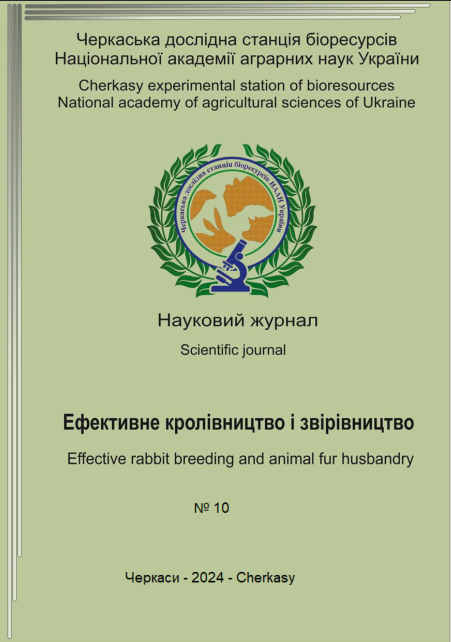ECONOMIC EFFICIENCY OF USING MALES IN CROSSING LINES OF RABBITS
DOI:
https://doi.org/10.37617/2708-0617.2024.10.131-143Keywords:
cross, line, productivity, economic efficiency, reproduction traitsAbstract
Overcoming hunger is one of the key Sustainable Development Goals defined by the United Nations. The development of rabbit breeding can become an important factor in solving this global problem of humanity, because this direction of animal husbandry, using modern resource-saving and highly efficient technologies of keeping and breeding, is able to provide the population with a valuable product for food.
The most economically profitable technology for producing rabbit products today is industrial rabbit breeding, which involves keeping them in rooms with a regulated microclimate, using complete feed in feeding, and growing rabbits obtained as a result of crossing specialized lines. Currently, the most important task of breeders in rabbit breeding is to develop the most effective crossbreeding schemes. This is preceded by large-scale work to create and improve the original lines of rabbits, which will be used in crosses and ensure high profitability of rabbit production. In this regard, the current problem of industrial rabbit breeding at the current stage of its development is the search for optimal cross schemes and improvement of existing rabbit selection systems.
The paper presents the results of studies conducted to study the economic efficiency of using males of the parental lines of the maternal form of the Hyla cross with different weight indices to obtain female rabbits of the maternal form of the cross with a high level of productivity. The studies were conducted in the conditions of LLC "Farm Krolikoff" of Cherkasy region. In the course of the experiments, the productivity and level of reproduction characteristics of males of the parental line of the maternal form of the Hyla GPC cross and female rabbits of the maternal form of the Hyla NG were studied. The calculation of economic parameters was also carried out and the profitability of using males with different weight indices was determined.
As a result of the conducted studies, it was found that males with a weight index of more than 120 units had the largest live weight (5.87 kg) and were characterized by higher values of ejaculate volume and sperm motility. Analysis of the experimental data showed that daughters of males with a weight index of more than 120 units had the highest values of multiparity (10.37 heads) and milk yield (6497.3 g), and also prevailed over peers obtained from males with a weight index of less than 100 units and from 100 to 120 units in terms of survival of rabbits to weaning.
Calculations of economic efficiency showed that the greatest profit can be obtained from the use of female rabbits that originated from males of the ancestral cross form with a weight index of more than 120 units. At the same time, the profitability of rabbit meat production was 35.11%.
References
Вакуленко І. С., Петраш В. С. Формування м’ясної продуктивності кролів у віковій динаміці. Науково-технічний бюлетень ІТ НААН. 2016. №116. С. 21-26;
Гончар О. Ф., Бойко О. В., Гавриш О. М. Аналіз стану галузі кролівництва в Україні. Effective rabbit breeding and fur farming. 2020. № 6. С. 47–58. URL: https://doi.org/10.37617/2708-0617.2020.6.47-58 .
Гончар О. Ф., Шевченко Є. А. Особливості cелекційно-генетичного моніторингу в кролівництві за ДНК-маркерами. Effective rabbit breeding and fur farming. 2020. № 5. С. 36–51. URL: https://doi.org/10.37617/2708-0617.2019.5.36-51.
Коцюбенко Г. А. Науково-практичні методи підвищення продуктивності кролів : монографія. Миколаїв : МНАУ, 2013. 191 с.
Коцюбенко Г. А. Ефективність застосування ввідного схрещування при покращенні продуктивних якостей кролів. Розведення і генетика тварин : мiжвiд. темат. наук. зб. 2009. № 43. С. 192–196.
Коцюбенко Г.А. Ефективність ведення галузі звірівництва і кролівництва в південному регіоні України. Тваринництво України. 2008. № 1. С. 8–9.
Divergent selection for longevity in breeding does. / Garreau, H., et al. In: 9th World Rabbit Congress. 2008. p. 97-101.
Economic weightsin rabbit meat production / L. Cartuche et al. World Rabbit Science. 2014. Vol. 22, no. 3. P. 165. URL: https://doi.org/10.4995/wrs.2014.1747 .
Effect sofintrauterinecrowding on available uterine space per fetus in rabbits / M. J. Argente et al. Livestock Science. 2008. Vol. 114, no. 2-3. P. 211–219. URL: https://doi.org/10.1016/j.livsci.2007.05.008
Efficien cyofcrossingpaternal line males and maternal line females of rabbits on growth performance / G. Abd El-latif et al. Egyptian Poultry Science Journal. 2021. Vol. 41, no. 4. P. 709–722. URL: https://doi.org/10.21608/epsj.2021.213293 .
Evaluation ofmilkyield and semen quality in maternal line of rabbits / I. Ali et al. Egyptian Poultry Science Journal. 2021. Vol. 41, no. 2. P. 413–428. URL: https://doi.org/10.21608/epsj.2021.182516 .
Fortun-Lamothe L., Sabater F. Estimation de la production laitière à partir de la croissance des lapereaux. 10èmes journ. rech. cunicole. 2003. P. 69–72.
García M., Argente M. The genetic improvement in meat rabbits. LagomorphaCharact. 2020. IntechOpen; London, UK, Volume 5. P. 1–13.
Gavrish O. M. Рівень продуктивності кролів різних порід та ефективність використання селекційних індексів в кролівництві. Animal Breeding and Genetics. 2015. Т. 55. С. 38–46. URL: https://doi.org/10.31073/abg.55.05 .
Gavrish O. M. Рівень продуктивності кролів різних порід та ефективність використання селекційних індексів в кролівництві. Animal Breeding and Genetics. 2015. Т. 55. С. 38–46. URL: https://doi.org/10.31073/abg.55.05 .
Genetic analyses of rabbit survival and individual birth weight / R. Belabbas et al. Animals. 2022. Vol. 12, no. 19. P. 2695. URL: https://doi.org/10.3390/ani12192695 .
Nied´zwiadek S. Zasadyhodowlikrólików. Warszawa : PWRiL, 1981. 357 p.
Relation ships betweenuterineand fetal traits in rabbits selected on uterine capacity1 / M. J. Argente et al. Journal of Animal Science. 2003. Vol. 81, no. 5. P. 1265–1273. URL: https://doi.org/10.2527/2003.8151265x .
The birth weight of rabbits: influencing factors and effect on behavioural, productive and reproductive traits: a review / Z. Szendrő et al. Livestock Science. 2019. Vol. 230. P. 103841. URL: https://doi.org/10.1016/j.livsci.2019.103841 .
Vintoniv O. A., Havrysh O. M. The reproductive ability of male rabbits depending on the influence of paratypical and genotypical factors. Animal Breeding and Genetics. 2022. No. 64. P. 147–153. https://doi.org/10.31073/abg.64.13.


